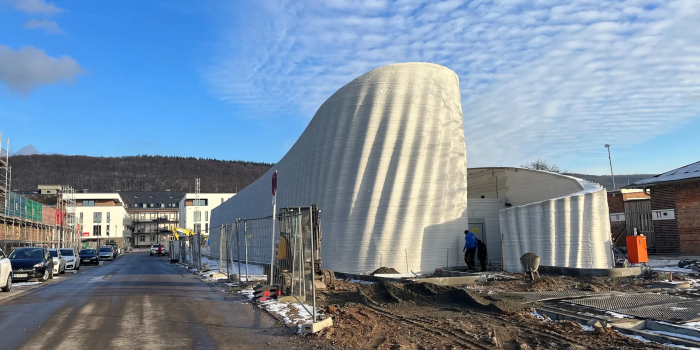The Wave House, a new data center built in urban Germany, is Europe’s largest 3D-printed building. The building broke the stereotype of boring buildings associated with the cloud computing infra.
Located in Heidelberg designed by SSV and Mense Korte, the building was created by Peri 3D Constructions for developer KrausGruppe. “Due to the typical absence of windows and large openings in all or the main areas of data centers, for safety and other reasons, data centers tend to look quite dull and uninspiring,” explained a press release by COBOD. “As long as such data centers are placed far outside the cities this problem is perhaps of less concern, but the trend towards making data centers more in the vicinity of the users and therefore locate them in suburban areas and cities has created a need to make the data centers more visually appealing.”

“The architects SSV and Mense Korte solved a challenge in the Heidelberg project by giving the walls a wave design, a design feature that also gave the building its name: the Wave House. Such wave-designed walls could not have been realized using conventional construction methods, so 3D construction printing technology was used due to the design freedom of this construction method.”
The build process used in the built of this data center is similar to other 3D-printed architecture projects that have been reported upon. The project used a single COBOD BOD2 printer, the same model which was also used in Europe’s first two-story house and the world’s largest 3D-printed building. The completion of the house took around 140 hours. Once the printer was done with its job, humans brought finishing touches in place. These included the roof, doors, lighting, wiring, and gear required for a modern data center.
The printing process took around 140 hours. Following this, humans then put the finishing touches to the project, including the roof and doors, plus the lighting and all the wiring and gear required for a modern internet-connected data center. At the end a robotic painter by Deutsche Amphibolin-Werke was used to paint the interior. One of the many positives that stem from 3D printing is lesser CO2 emissions in comparison to traditional methods. Time saving was another plus, as the project took over 6 months.
3D printing has moved into mainstream construction over the last few years. The data center comes after a score of different successful projects have been erected using 3D printing. An earthquake-resistant 3D-printed house, the world’s tallest 3D-printed tower, and an ambitious development of 100 3D-printed homes are projects. The firm behind the Wave House’s construction says it eyes to eventually automate a minimum of 50% of construction processes on building sites.


